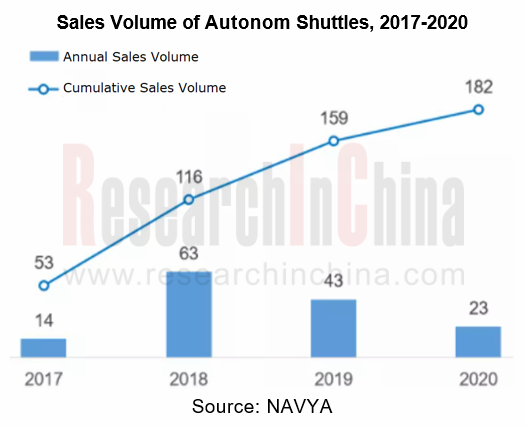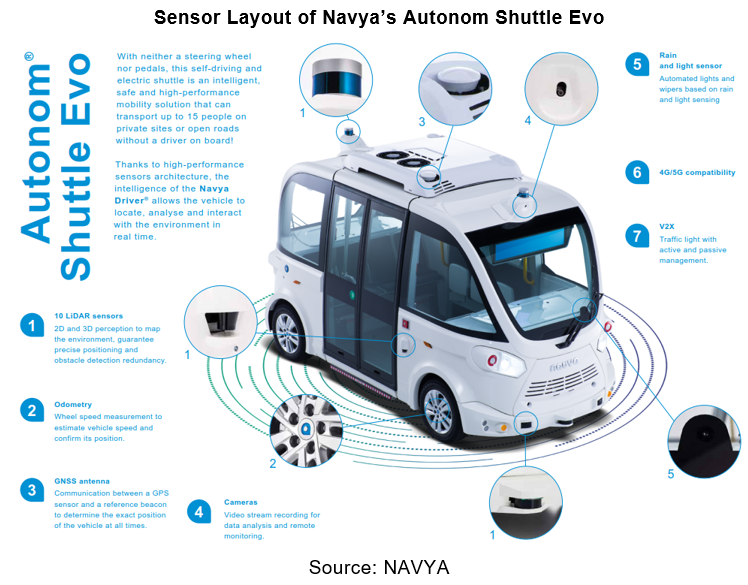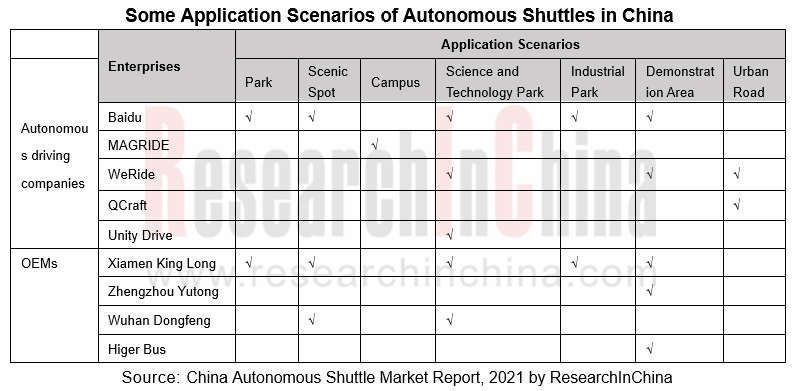This report studies autonomous vehicles that transport passengers on short distances, and delves in the product solutions, operational services, and major players in this market.
The development of autonomous shuttles slows down
Many companies, including start-ups, Tier 1 suppliers and automakers (like UISEE, Baidu, Bosch, Continental, Dongfeng, Yutong, etc.), will launch autonomous shuttles when trying to develop and test L4 technology, so as to verify the reliability of their autonomous driving solutions.
Among them, Navya and EasyMile, which are the first to enter the autonomous shuttle market, perform mediocrely.

In fact, the smart sensor configuration of L2+ passenger cars has been developing at an amazing speed, and suppliers such as Baidu have applied L4 technology to the L2+ market. L4 autonomous shuttles have developed slowly in the past two years. Although new players have flooded to the autonomous shuttle market, the development momentum herein is obviously not as good as that of the ADAS market and the autonomous driving market for special vehicles (such as autonomous driving in agriculture, mines and ports).
In terms of sensor configuration, autonomous shuttles lag behind the most cutting-edge passenger cars.
For example, Navya’s autonomous shuttle --- Autonom Shuttle Evo uses a lidar + front/rear view camera solution to enable L4 autonomous driving featuring capabilities such as straight driving, turning, U-turning at intersections, autonomous obstacle avoidance, and fixed site parking. It also supports background remote control.

Baidu’s autonomous shuttle Apollo adopts a fusion solution of lidar + radar + front/rear view camera + surround view camera + ultrasonic radar to independently complete a series of driving capabilities such as autonomously exit from parking spaces, following cars, avoiding obstacles, turning/turning around, stopping at stations, etc.

The autonomous shuttle market in China is obviously more booming than abroad
Autonomous shuttles mainly operate in parks, scenic spots, campuses, science and technology parks, industrial parks, demonstration areas and other closed/semi-closed or relatively simple mixed traffic environments, where there are a few vehicles and pedestrians and vehicles run slowly. These scenarios are a good starting point for fast realization and commercialization of autonomous driving.
The autonomous shuttle market in China is obviously more booming than abroad. Baidu’s autonomous shuttles are available in the most scenarios. "Apollo" jointly created by Baidu and Xiamen King Long since 2018 has landed in 35 parks in 28 cities of China. In addition, autonomous driving startups (such as MAGRIDE, WeRide, and QCraft) as well as OEMs (like Xiamen King Long and Zhengzhou Yutong) are actively embarking on this market.

Navya: Global autonomous shuttle sales volume will reach 12,600 units in 2025
The autonomous shuttle market tends to develop more slowly, but it represents a typical scenario for autonomous driving and still attracts more and more players to join. According to the investor report released by Navya in January 2021, the global autonomous shuttle sales volume will reach 12,600 units by 2025, with a market value of EUR1.7 billion.
The autonomous shuttle market will thrive sooner or later, but the crucial problem is who can survive the difficult time. At present, autonomous shuttle enterprises are trying to find successful development paths through various forms of cooperation. We have summarized two paths as below.
Path 1: Autonomous shuttle enterprises and OEMs/Tier1s team up to complement advantages
Autonomous shuttle players --- autonomous driving startups, OEMs (buses, passenger cars) and Tier 1 suppliers s have their respective advantages:
- With full-stack layout capabilities in autonomous driving solutions, autonomous driving startups provide L4 autonomous shuttles through OEM cooperation or AM modification.
- Some OEMs use their own vehicle manufacturing capabilities to pre-install and integrate autonomous driving software, algorithms, sensors, etc., and directly embark on actuation.
- The capabilities of Tier1 suppliers in software & hardware layout and system integration cannot be underestimated.
The cooperation between autonomous driving startups, OEMs and Tier1 suppliers is conducive to achieving complementary advantages and enhancing competitiveness.
In March 2021, GM Cruise acquired Voyage, a self-driving car startup that focused on operation in retirement communities. The cooperation will merge Cruise’s engineering and software capabilities with Voyage’s presence in the retirement community market to launch bombshells.

Path 2: Expansion of scenarios and technical service capabilities
Autonomous shuttles have something in common with autonomous logistics vehicles and autonomous taxis in terms of technical solutions, featuring relatively low thresholds to different scenarios.
The French company Navya, which initially engaged in autonomous shuttles, launched Autonom Cab, a driverless taxi, in 2018.
After completing the layout in autonomous taxis, WeRide has dabbled in the autonomous buses and autonomous logistics successively.
In early 2021, WeRide and Yutong jointly built Mini Robobus, and started the normalization test in Guangzhou International Bio Tech Island and Nanjing Eco Hi-Tech Island. Mini Robobus will spread to Zhengzhou, Wuhan and other cities for normalization tests, and it will be commercialized in 2021. Mini Robobus is designed for urban open roads to gradually break the limits of the park scenario and blur the boundary with RoboTaxi.
In March 2021, WeRide acquired MoonX. They will collaborate in business. MoonX, which focuses on autonomous logistics vehicles, is expected to help WeRide realize its expansion in the field of unmanned logistics.
In addition to the above two paths, there must be other paths. Under the background of unclear business models, the expansion, cooperation, mergers and acquisitions of autonomous shuttle companies will occur constantly.
Global and Chinese Automakers’ Modular Platforms and Technology Planning Research Report, 2022
Research on Automakers’ Platforms and Their Planning: the Strategic Layout Directions of 32 Automakers
At present, global automotive industry is in the midst of profound changes unseen in a century....
Automotive Intelligent Cockpit Platform Research Report, 2022
Research on Intelligent Cockpit Platforms: Intelligent cockpits rush into a new era of "cross-domain integration and layered software design"
Cockpit hardware platform field: Faster cross-domain inte...
Global and China Flying Car Industry Research Report, 2022
ResearchInChina has released “Global and China Flying Car Industry Research Report, 2022".
A flying car is a three-dimensional vehicle. Broadly speaking, it is a low-altitude intelligent autonomous t...
Global and China Passenger Car T-Box Market Report, 2022
Passenger car T-BOX research: T-Box OEM installation rate will reach 83.5% in China in 2025
ResearchInChina has published Global and China Passenger Car T-Box Market Report 2022 to summarize and ana...
Global and China Purpose Built Vehicle (PBV) and Robocar Report, 2022
PBV and Robocar research: new idea of building brick cars, a new car type for future mobility Building brick cars moves the cheese of traditional OEMs.
Purpose built vehicle (PBV) refers to special ...
China Automotive Voice Industry Report, 2021-2022
Automotive voice market: The boom of self-research by OEMs will promote reform in the supply mode
Before the advent of fully automated driving, the user focus on driving, and voice interaction is sti...
Global and China Automotive Emergency Call (eCall) System Market Report, 2022
Automotive eCall system: wait for the release of policies empowering intelligent connected vehicle safetyAt the Two Sessions held in March 2022, more than 10 deputies to the National People's Congress...
Global and China Leading Tier1 Suppliers’ Intelligent Cockpit Business Research Report, 2022 (II)
Tier1 Intelligent Cockpit Research: The mass production of innovative cockpits gathers pace, and penetration of new technologies is on a rapid riseGlobal OEMs and Tier 1 suppliers are racing for the i...
Global and China Leading Tier1 Suppliers’ Intelligent Cockpit Business Research Report, 2022 (I)
Tier1 Intelligent Cockpit Research: The mass production of innovative cockpits gathers pace, and penetration of new technologies is on a rapid riseGlobal OEMs and Tier 1 suppliers are racing for the i...
China Commercial Vehicle Intelligent Cockpit Industry Report 2021
Research on Intelligent Cockpits of Commercial Vehicles: Heading for Large Screens, Voice Interaction, Entertainment and Life
Following AD/ADAS functions, the intelligent configuration of the cockpit...
Automotive Ultra Wide Band (UWB) Industry Report, 2022
UWB got initially utilized in the military field, and began to be commercially applied after the release of criteria for UWB commercialization in 2002. In 2019, Car Connectivity Consortium (CCC) liste...
China Automotive Distribution and Aftermarket Industry Report, 2022-2027
Since the introduction of 4S store model into China at the end of 20th century, China's authorized dealer system has gradually developed from a single-store-based mode to a group-based mode, and from ...
Global and China Skateboard Chassis Industry Report, 2021-2022
Research into skateboard chassis: where to sell, how to sell and to whom it is sold
Rivian, a new carmaker based on skateboard chassis, is quite popular in the market and becomes the focus of the aut...
Emerging Automakers Strategy Research Report, 2022--NIO
Research on emerging carmaking strategies: no new cars in 2021, 3 new cars in 2022, can NIO make its renaissance?
The delivery of ET7 is imminent, and the sluggish sales situation is expected to fade...
Automotive and 5G Industry Integration Development Report, 2022
Research on integration of vehicle and 5G: OEMs rush into mass production of 5G models whose sales may reach 3.68 million units in 2025
By the end of 2021, China had built and opened in excess of 1.3...
China Automotive Finance Industry Report, 2022-2030
Auto finance is lucrative with the highest profit margin in the international automobile industry chain, contributing to roughly 23% of the global automobile industry profits. Yet, auto finance only h...
Global and China Power Battery Management System (BMS) Industry Report, 2022-2026
1. Robust demand from new energy vehicle spurs BMS market to boom
New energy vehicle sales have been growing rapidly worldwide over the recent years, reaching 6.5 million units with a year-on-year up...
ADAS/AD Chip Industry Research Report, 2022
Autonomous driving chip research: In addition to computing power, core IP, software stacks, AI training platforms, etc. are becoming more and more importantL2.5 and L2.9 have achieved mass production ...